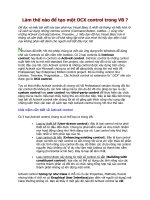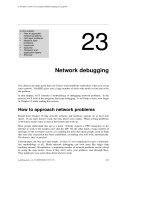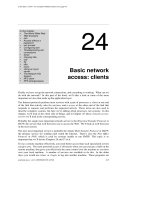Tài liệu Chapter 13 Wired LANs: Ethernet docx
Bạn đang xem bản rút gọn của tài liệu. Xem và tải ngay bản đầy đủ của tài liệu tại đây (845.59 KB, 40 trang )
13.1
Chapter 13
Wired LANs: Ethernet
Copyright © The McGraw-Hill Companies, Inc. Permission required for reproduction or display.
13.2
13-1 IEEE STANDARDS
13-1 IEEE STANDARDS
In 1985, the Computer Society of the IEEE started a
In 1985, the Computer Society of the IEEE started a
project, called Project 802, to set standards to enable
project, called Project 802, to set standards to enable
intercommunication among equipment from a variety
intercommunication among equipment from a variety
of manufacturers. Project 802 is a way of specifying
of manufacturers. Project 802 is a way of specifying
functions of the physical layer and the data link layer
functions of the physical layer and the data link layer
of major LAN protocols.
of major LAN protocols.
Data Link Layer
Physical Layer
Topics discussed in this section:
Topics discussed in this section:
13.3
Figure 13.1 IEEE standard for LANs
13.4
Figure 13.2 HDLC frame compared with LLC and MAC frames
13.5
13-2 STANDARD ETHERNET
13-2 STANDARD ETHERNET
The original Ethernet was created in 1976 at Xerox’s
The original Ethernet was created in 1976 at Xerox’s
Palo Alto Research Center (PARC). Since then, it has
Palo Alto Research Center (PARC). Since then, it has
gone through four generations. We briefly discuss the
gone through four generations. We briefly discuss the
Standard (or traditional) Ethernet
Standard (or traditional) Ethernet
in this section.
in this section.
MAC Sublayer
Physical Layer
Topics discussed in this section:
Topics discussed in this section:
13.6
Figure 13.3 Ethernet evolution through four generations
13.7
Figure 13.4 802.3 MAC frame
13.8
Figure 13.5 Minimum and maximum lengths
13.9
Frame length:
Minimum: 64 bytes (512 bits)
Maximum: 1518 bytes (12,144 bits)
Note
13.10
Figure 13.6 Example of an Ethernet address in hexadecimal notation
13.11
Figure 13.7 Unicast and multicast addresses
13.12
The least significant bit of the first byte
defines the type of address.
If the bit is 0, the address is unicast;
otherwise, it is multicast.
Note
13.13
The broadcast destination address is a
special case of the multicast address in
which all bits are 1s.
Note
13.14
Define the type of the following destination addresses:
a. 4A:30:10:21:10:1A b. 47:20:1B:2E:08:EE
c. FF:FF:FF:FF:FF:FF
Solution
To find the type of the address, we need to look
at the second hexadecimal digit from the left. If
it is even, the address is unicast. If it is odd, the
address is multicast. If all digits are F’s, the
address is broadcast. Therefore, we have the
following:
a. This is a unicast address because A in binary
is 1010.
b. This is a multicast address because 7 in
binary is 0111.
c. This is a broadcast address because all digits
are F’s.
Example 13.1
13.15
Show how the address 47:20:1B:2E:08:EE is sent out on
line.
Solution
The address is sent left-to-right, byte by byte; for
each byte, it is sent right-to-left, bit by bit, as
shown below:
Example 13.2
13.16
Figure 13.8 Categories of Standard Ethernet
13.17
Figure 13.9 Encoding in a Standard Ethernet implementation
13.18
Figure 13.10 10Base5 implementation
13.19
Figure 13.11 10Base2 implementation
13.20
Figure 13.12 10Base-T implementation
13.21
Figure 13.13 10Base-F implementation
13.22
Table 13.1 Summary of Standard Ethernet implementations
13.23
13-3 CHANGES IN THE STANDARD
13-3 CHANGES IN THE STANDARD
The 10-Mbps Standard Ethernet has gone through
The 10-Mbps Standard Ethernet has gone through
several changes before moving to the higher data
several changes before moving to the higher data
rates. These changes actually opened the road to the
rates. These changes actually opened the road to the
evolution of the Ethernet to become compatible with
evolution of the Ethernet to become compatible with
other high-data-rate LANs.
other high-data-rate LANs.
Bridged Ethernet
Switched Ethernet
Full-Duplex Ethernet
Topics discussed in this section:
Topics discussed in this section:
13.24
Figure 13.14 Sharing bandwidth
13.25
Figure 13.15 A network with and without a bridge









